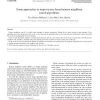Free Online Productivity Tools
i2Speak
i2Symbol
i2OCR
iTex2Img
iWeb2Print
iWeb2Shot
i2Type
iPdf2Split
iPdf2Merge
i2Bopomofo
i2Arabic
i2Style
i2Image
i2PDF
iLatex2Rtf
Sci2ools
PR
2006
2006
Some approaches to improve tree-based nearest neighbour search algorithms
Nearest neighbour search is a widely used technique in pattern recognition. During the last three decades a large number of fast algorithms have been proposed. In this work we are interested in algorithms that can be used with any dissimilarity function provided that it fits the mathematical notion of distance. Some of such algorithms organize, in preprocessing time, the data in a tree structure that is traversed in search time to find the nearest neighbour. The speedup is obtained using some pruning rules that avoid the traversal of some parts of the tree. In this work two new decomposition methods to build the tree and three new pruning rules are explored. The behaviour of our proposal is studied through experiments with synthetic and real data. 2005 Pattern Recognition Society. Published by Elsevier Ltd. All rights reserved.
Related Content
| Added | 14 Dec 2010 |
| Updated | 14 Dec 2010 |
| Type | Journal |
| Year | 2006 |
| Where | PR |
| Authors | Eva Gómez-Ballester, Luisa Micó, José Oncina |
Comments (0)

